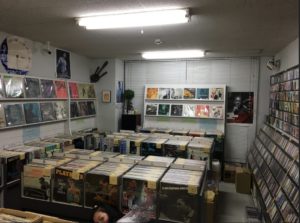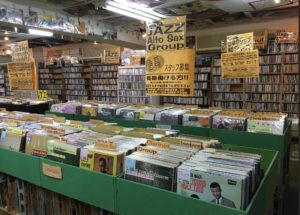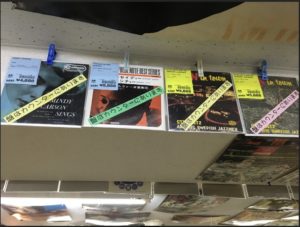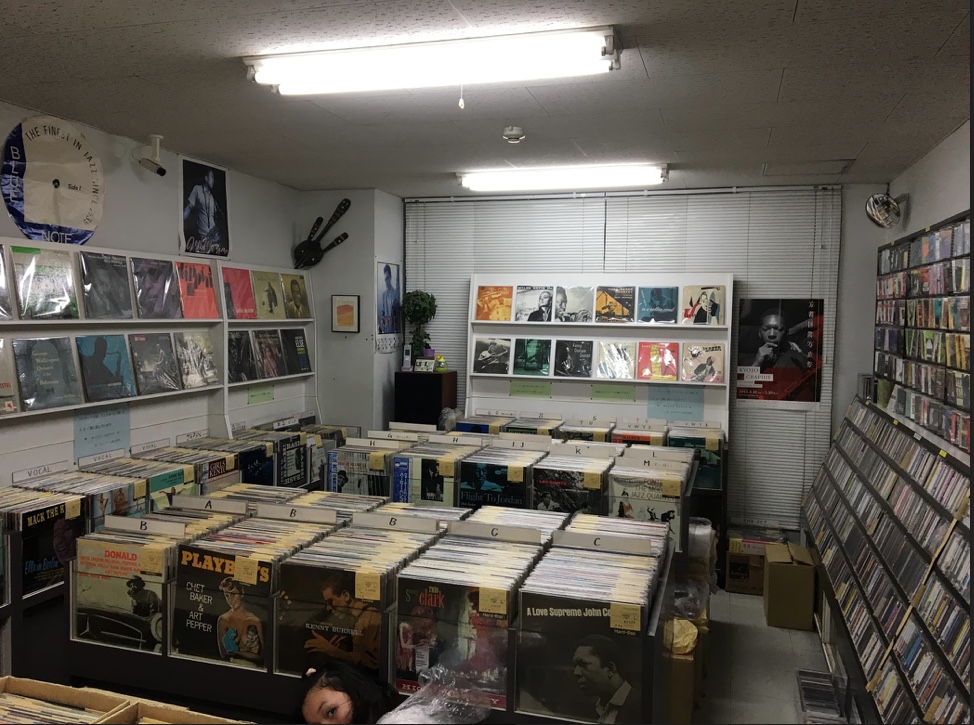Guest Column: Japan Record Shopping, Part One, Or How to Manage a Dense, Unwieldy Carry-On

Overall view of Hard Bop Records, Kyoto, with many nice records on the wall, many more at the front not shown
I’m Steven Frost, a longtime reader of Jazz Collector and jazz music aficionado. I reached out to Al to see if he’d be interested in me writing about my jazz record-related adventures on a family summer trip to Japan. Initially my computer had some keyboard issues after arrival and it looked like I’d need to wait until I returned to the States to document the trip, yet a couple of days ago my Macbook keyboard miraculously healed itself. It must be related to all the wonderful temples we have visited since arriving here.
I looked forward to this trip for a long time, having spent many years in China, but never having the opportunity for an extended trip to Japan. My first encounter with the Japanese appreciation for jazz had come as a college student in 1991. Not long after settling in my dorm room in Beijing I was playing something by Coltrane on a boombox when a knock came on the door. It was a Japanese student I’d never met who looked at me and only said, “Coltrane.” Then he took me by the arm and walked me down the hall to his room and opened the door. My eyes were greeted by a large Impulse era poster of Coltrane he’d obviously brought from home, sitting on a large tripod by his desk. I have purchased a number of records from Japanese sellers over the years and also have a fondness for Japanese phono cartridges, but was very curious to see if my impression of Japan as a jazz loving country, one developed from afar, would be reinforced by an actual visit here.
My adventure started in a suburb of Tokyo called Ikebukuro, where we spent several days getting acclimated and combatting jet lag. The first stop was Daruma-ya, a large store in terms of inventory (supposedly more than 100,000 titles), but like most Japanese urban spaces the space was at a premium, making it feel a little overwhelming. Daruma-ya is located the upper floor of a nondescript multi-story building in what appeared to be Ikebukuro’s red light district, cocktails with 100% guaranteed college students anyone? The need to develop a vertically oriented sense of space was, for me, the only really challenging aspect of navigating Japan. Nearly every store I visited was located above street level in a multi- story building, and Google Maps can sometimes be confusing in Japan’s dense urban areas, a thought I’ll return to later.
Daruma-ya is like walking into a candy store, albeit one where the candy is dusty and expensive. They have a selection of thousands of jazz and blues lp’s, many of which are original pressings. The organizational principle at Daruma- ya seems logical (a theme to be repeated other places) where generally records are organized by instrument and then leader of the recording date, but sometimes alphabetical order is randomly violated. Are records filed alphabetically by performer first name, or last name? Depending on your level of OCD, this can be a welcome adventure, or mildly annoying. T
he selection of fine records at Darum-ya was impressive, and everything I remember looking at was clean and in VG+ or better condition. There are also thousands of 45’s, a format that has remained very strong in Japan. It felt like the owner’s pricing strategy was to find the highest price paid for specific titles on Popsike and price his records accordingly. I found an original pressing of Dizzy Reece- Asia Minor and was ready to pull the trigger for what I thought was a fair cash offer, but had to walk away.
I like to buy items from brick and mortar establishments whenever possible, because I really enjoy record shopping in a physical store, and appreciate the commitment it takes to be a retailer, but I also find as I get older it is satisfying to find bargains or at least what I consider to be reasonable prices. I picked up several Japanese pressings here, and would likely have bought much more if I did not feel the owner was trying to sell every record for the highest possible price on the best day.
The next afternoon I visited the Disk Union Ikebukuro branch. Disk Union operates a number of stores in Tokyo and Osaka. Some liken the store to a supermarket for records. Locating Disk Union was an adventure in itself. On a hot, humid, crowded afternoon in Tokyo with the sun beating down I walked passed the store at least three times before finally figuring out it was on the fourth floor of a non-descript building; above a Thai Restaurant, a boutique and a Denny’s restaurant. After my visit to Daruma-ya I was pleasantly surprised to find several thousand records in the jazz section, a store full of shoppers buying things, and surprisingly reasonable prices. I picked up a clean VG+ second pressing of Introducing Carl Perkins on Dootone for $6. There was also a nice original Fontana UK pressing of Tubby Hayes, Mexican Green, priced too inexpensively that I somehow stupidly didn’t buy (because I reasoned that I had a reissue that sounds great and I like the music so much I’m not thinking about the sound… blasphemy I know). When I returned at the end of my journey intending to snatch it up, it was gone, of course. The Ikebukuro location is not a well- known branch of Disk Union, but I wondered to myself walking down the street after shopping, “if this is the second-tier store I can only imagine what the branches closer to central Tokyo and Osaka must be like.”
Our next stop was Kyoto, Japan’s historic capital. Kyoto is a requisite stop for first-time visitors to Japan, and also for hordes of uniformed high school students. There are a ton of record stores in Kyoto, and I only had time to visit five to seven located in close proximity of one another. Maybe if I had been looking for other things besides jazz records visiting these stores would have been more memorable. I did have an interesting experience when I visited a store called Joe’s Garage, whose logo was the Warhol Velvet Underground banana. My wife and daughter were shopping so I randomly put “record store” into Google Maps. The result was in Japanese but I followed the arrow down the narrow, crowded street. I passed the front door several times before figuring out the right doorway. On the second floor of a building was a group of ladies in what looked like a hair salon that also sold boutique women’s clothing. At the end of the hall was a cryptic cardboard sign in English and Japanese on a door stating: “Joe’s Garage: This is not an entrance. The entrance is around the side.” I went outside the building to look for an alternative entrance on the non- existent “side” and was unable to find one, so I started walking away, before thinking the sign might be some sort of ruse or Zappa insider joke to see if customers were clued in. I went back upstairs and turned the non-entrance door handle. Finding it unlocked I walked into ceiling-high boxes of records with a narrow passage between them. Upon rounding a corner there was a tightly packed store with lots of nice things, particularly if you were into classic rock. I must have spent several minutes in there looking at records by myself before the owner, who looked like a Japanese classic rocker himself, emerged from the back. When I mentioned the strange entrance into the store he pointed around another corner behind me. The front door to the record store was through the ladies’ salon next door. Who knew?
The only interesting discovery I made in terms of first pressings in my wandering around Kyoto to this point was a tatty copy of Charles Tolliver’s Music Inc. two-LP set recorded live in Loosdrechdt, Netherlands for under $10. In fairness, I was so quickly spoiled by the great record shopping I’d encountered in the suburbs of Tokyo, I had already developed high expectations.
I must note one outstanding exclusively jazz store in Kyoto called… Art Blakey drum roll please… Hard Bop.
This store seems like a true labor of love and I wish I’d had more time to look around. Hard Bop had at least 5,000 to 7,000 titles with many original pressings mixed with superb condition Japanese reissues. The owner of Hard Bop had many desirable records in his stacks and on the wall, some of which are in the accompanying photos, and whose covers will be recognizable to readers of this website. Unlike Daruma-ya, where the owner seemed acutely in tune with the global online record market, the owner of Hard Bop seemed to live in a world where computers had not been invented yet. He was playing a CD-only title by Steve Kuhn Trio on Venus Records. Steve Kuhn was an artist I wasn’t familiar with but really dug, and I ended up getting a Steve Kuhn Trio LP on Venus here along with a couple of other records. I imagine most JC readers are familiar with the Japanese Venus label, which produces really elegantly packaged, well- engineered recordings that sell for premium prices. I figured these Venus titles would be a little less expensive in Japan, but they are obviously very desirable for Japanese jazz fans too. The most entertaining aspect of the visit to Hard Bop was the elderly owner having a Lost-in-Translation conversation with my teenage daughter. He spoke no English and my daughter speaks no Japanese. She can be seen hiding between the aisles as I took an overall photo of the space.
By the time I left Kyoto I had approximately 15 records making my Japan tour with me, less than a week into the trip. How soon would this grow into a larger, “why-the-hell-am-I-lugging-all-these-records-across-Japan” load? Stay tuned for part two.

A nice selection of original 10” records at Hard Bop, including a beautiful copy of Zoot Sims in Hollywood





Having been to Japan twice but only during layovers on the trip elsewhere I only had a brief chance to look through some of the great records that they have there every week or every week having been to Japan twice but only during layovers on the trip elsewhere I only had a brief chance to look through some of the great records that they have there every month I go to a Baltimore record show and they are many Japanese buyers there grabbing all the clean original pressings and I see now where they go. I would love to get a chance to go back to Japan and bring someone great American workers back home but they are well worth because they are classics. I am Ron Carter official biographer and he often goes to Japan on tour and sends me back pictures like what is seen in this post. Glad the music is getting the attention it deserves But a little bit disappointed that many good records are over there just for them to be sold back to here.
everyone here has lamented the disappearance of record shops both in the USA and in Europe. this doesn’t seem a problem in Japan. being the World the current market, eBay and Discogs, it’s likely that specialized shops in Japan buy what’s on the global market and offer these items as the pics in this post show. anyone in Europe or elsewhere other than Japan has seen such walls in the last decades? not me, and I travelled a lot. to be lucky, one or two nice records, then the desert. recently Korea appeared a good harbor for great records while Japan established its interest back in the 60’s. as I said, many of us, especially USA collectors let their gems go eastbound and it’s there we can find them now.
Perfect timing for my first trip to Japan coming up in 4 weeks. I’ll definitely be checking out Hard Bop. What a wall!
I love this post and can’t wait for part 2. My wife and I were in Kyoto for a month in 2001. In that time I probably visited every shop in Kyoto and Osaka. I thought Hard Bop was the best store of them all. I still have their bag and small hand outs as well as many records. Your pictures brought back fond memories. I’m glad to see it has survived and thrived. My wife was most impressed by the cleanliness of all the shops (as opposed to my dusty store) so it’s a bit of a surprise to hear about your first stop at a musty Tokyo shop. I guess there are exceptions to every rule.
Bill, “musty” is a relative term. The owner of Hard Bop was definitely the genuine article. I wish I’d had more time there.
Terrific article and looking forward to part two. Glad to see you’re doing well Steven, I hope you remember me from the Facebook group. Timely article for me since I will be heading to Tokyo in Nov with my wife and sister in law. While they are shopping I hope to hit many of these stores you listed. I hope I won’t get lost since it looks like some of these shops are quite difficult to find!
This, for me, is extremely interesting. I follow the Japanese market very closely, as a huge chunk of all the top collectibles in top condition are over there. From what I’ve gathered, the Japanese came over to the US and Europe in the 80’s and 90’s and bought almost everything. Seems like what collectors scramble for over here in the west are the few items still available in decent condition. But it definitely seems like the majority of the really great stuff resides in Japan.
Looking forward with great excitement to part two. Great writing Steven.
By the way, here’s a link to a video from Nate The Vinyl Guide visiting Hard Bop Records in Kyoto: https://www.youtube.com/watch?v=Ghj6iyeQy3A
Enjoy!
I really enjoyed your article and the photos. I’m looking forward to all your future submissions, especially part 2!